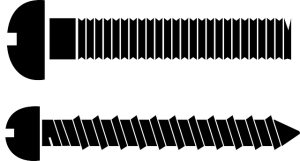
A tapered shank is a common characteristic of most screws. From drywall screws and lag screws to particle board screws and sheet metal screws, most screws have a tapered shank. Bolts, on the other hand, may or may not have a tapered shank. Unless you’re familiar with these fasteners, you might be wondering why screws have a tapered shank.
What Is a Tapered Shank?
A tapered shank means the long shaft of a threaded fastener, such as a screw, becomes narrower from the tip to the head. The tip is the end of a fastener. It’s connected to the shaft in the middle, which leads to the head. Screws with a tapered shank aren’t perfectly straight. Rather, they become narrower from the tip towards the head. This feature is known as a “tapered shank” because the shank narrows or tapers from the tip to the head.
The Purpose of a Tapered Shank
With a tapered shank, screws can be driven directly into objects. The objects with which they are used don’t require a pre-drilled hole that’s sized to fit a given screw. Instead, a screw with a tapered shank can be driven directly into the objects. A tapered shank allows for a pointed end, which isn’t possible with a non-tapered shank. The pointed end will essentially become narrower towards the head. With this tapered design, screws can dig into the material of an object to hold or secure it in place.
While useful for driving screws directly into objects, a tapered shank may prevent screws from accepting a nut. A nut is a fastener that’s used to distribute the load of a threaded fastener. They are typically used with bolts, which oftentimes don’t have a tapered shank. If a screw has a tapered shank, it usually won’t support a nut. Nuts have threading that’s designed to fit a fastener of a specific size. You can’t fit them around a tapered shank because the shank’s size changes from the tip to the head.
In Conclusion
Screws have a tapered shank so that they can be driven directly into objects. The shank is the shaft of a threaded fastener. Some fasteners have a tapered shank that becomes narrower from the point to the head, whereas others have a straight and non-tapered shank. With a tapered shank, you can drive screws directly into objects.
